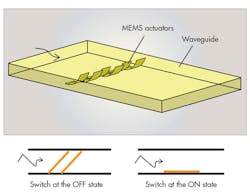MEMS Switch Hits Millimeter-Wave Frequencies
Components such as millimeter-wave switches will be critical to the use of millimeter-wave frequencies beyond 60 GHz for ultra-high-data-rate wireless telecommunications. A cost-effective and reliable approach that can scale with mass consumer technologies also is necessary for millimeter-wave applications. Taking a step toward these goals, researchers at the University of Alberta, in Edmonton, Canada—Nahid Vahabisani and Mojgan Deneshmand—developed a monolithic wafer-level, microelectromechanical-systems (MEMS) waveguide switch for millimeter-wave applications.
The pair designed the waveguide switch using staggered layers of MEMS actuators based on cantilever structures. The actuators are designed to bridge their contact from the bottom groundplane to the grounded top plane of the waveguide. Essentially, they create a high-impedance node as a function of electrical-stimulus to the actuators.
To analyze the cantilever’s ability to create an effective short against the waveguide surface, a simulation and fabrication study of 400- μm and 1-mm lengths and 50- μm and 100- μm widths was performed. The experimental results yielded a wideband switch covering 60 to 75 GHz that exhibits on-state insertion loss down to 0.2 dB and off-state isolation of 22 dB. Additionally, the researchers demonstrated a low-loss waveguide-to-coplanar-waveguide transition, which is integrated within the switch. It enabled back-to-back configuration loss below 1.1 dB across the band as well as on-wafer characterization. See “Monolithic Millimeter-Wave MEMS Waveguide Switch,” IEEE Transactions on Microwave Theory and Techniques, Feb. 2015, p. 340-351.
About the Author
Jean-Jacques DeLisle
Jean-Jacques graduated from the Rochester Institute of Technology, where he completed his Master of Science in Electrical Engineering. In his studies, Jean-Jacques focused on Control Systems Design, Mixed-Signal IC Design, and RF Design. His research focus was in smart-sensor platform design for RF connector applications for the telecommunications industry. During his research, Jean-Jacques developed a passion for the field of RF/microwaves and expanded his knowledge by doing R&D for the telecommunications industry.

